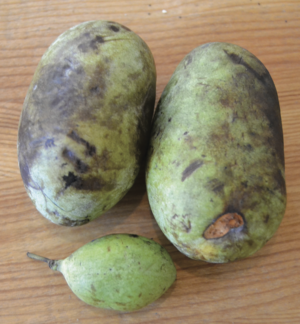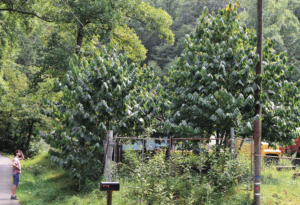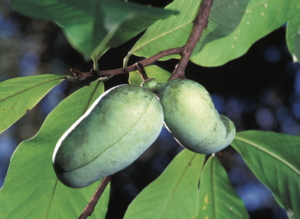What in the World is a Pawpaw?
Do you know what a pawpaw is? A few generations ago, most would say “yes!” You could ask just about anyone and they could tell you what this fruit looked and tasted like, and more importantly, where to find it. But today, the pawpaw remains a mystery to some and entirely unknown to others.
With the local food movement on the rise and more and more people looking for a deeper connection to what they eat, the sweet, custard-like pawpaw just might be placed back on the American plate.
The following is an excerpt from Pawpaw by Andrew Moore. It has been adapted for the web.

A comparison of wild and cultivated fruit.
Throughout the years it’s gone by a lot of names—frost banana, Indiana banana, fetid-bush, bandango, custard apple, prairie banana, poor man’s banana—but most of the time it’s just been called pawpaw. At first glance, both the fruit and the tree seem out of place in North America. A cluster of young pawpaws hanging from its branch resembles a miniature hand of bananas. And those clusters are tucked behind the tree’s lush foliage, shaded by leaves often a foot in length, larger and broader than those of avocado or mango. Wild pawpaws often appear kidney-shaped, two to six inches long, and one to three inches wide; they typically weigh from just a few ounces to half a pound. But under cultivation—and yes, there are pawpaw breeders and growers—fruits that weigh more than a pound and a half are not uncommon.
American landscapes are filled with berries, plums, persimmons, grapes, and all sorts of other edible fruits. But there is no native fruit as large as pawpaw. To walk into a wild grove is unlike any other American foraging experience. Rock-hard when underripe, the pawpaw eventually turns as delicate and fragile as a raspberry, and only at this stage of extreme vulnerability is it ready to be picked. If unpicked by human hands, ripe fruit will fall to the ground (hence the chorus of the American folk song: “Picking up pawpaws / Put ’em in a basket / Way down yonder in the pawpaw patch”) and can then be eaten. Or, if you don’t want to wait for them to fall on their own accord, a shake of the tree’s trunk will release any fruits that are ready. But you must be gentle: Any unripe fruits shaken down too early will fail to ripen at all. A prematurely picked pawpaw will turn black and rot, yet never sweeten to its potential.
In the Deep South, pawpaws usually begin to ripen in late July or early August; in the mid-Atlantic and Ohio River Valley, early September; and in the fruit’s northernmost range, with fruit ripening in mid-to late September, pawpaws can be picked as late as the middle of October. Each tree produces ripe fruit for about thirty days. But, as with everything else in nature, the timetables depend on fluctuations in weather. I’ve begun to associate pawpaw with goldenrod: When the fields are yellow with the latter’s bloom, it’s time to check the pawpaw patch.
Pawpaws vary greatly from tree to tree, but even fruit from a single tree will differ in taste considerably depending on its ripeness, the amount of sunlight it receives, and a host of other factors. There is a stage in the ripe fruit’s development when its flavor is perfect, but this, of course, is subjective. Regardless, after it’s picked, the pawpaw’s skin will begin to blacken in just three days, and its sweetness will intensify until caramel is the overwhelming flavor and scent. Alabamian Dale Brooks once told me you can judge a good pawpaw the same way you judge a Cajun gumbo. “If after you eat it and a minute later you start to talk and your lips stick together—that’s a good one.”
Many old-timers who grew up with the fruit as children would never eat a “green” pawpaw. “If you let them fall off, lay them up on the windowsill, and let them get real black—oh man, they’re real good!” For them, the only ripe pawpaw is purple-black, shriveled, and incredibly sweet. “My favorite pawpaw is one that’s black and starting to ferment just a little bit,” another man told me in eastern Kentucky. “It tastes like wine, pawpaw wine.” Others, however, prefer a pawpaw just a couple of days after it’s picked, when the flesh is still firm and bright, its flavor sweet and mild.

Jon looks for fruit in a grove of pawpaws in eastern Kentucky, a few miles from the state-line village of Paw Paw.
The pawpaw’s flavor is most often described as a cross between banana and mango, hence “bandango.” But again, they vary greatly. Wynn Dinnsen, a pawpaw grower in Pittsboro, North Carolina, keeps a log describing the fruits of more than two hundred unique trees he has raised from seed, including notes on their weight, seed-to-pulp ratio, and flavor. In the pages of his notebook, slightly stained from pawpaw pulp, he has recorded flavors ranging from melon and pineapple to cotton candy and anise. A “Hoosier lad” once told author Euell Gibbons, “They taste like mixed bananers and pears, and feel like sweet pertaters in your mouth.”1 Jerry Dedon, a grower in Louisiana, says there are just two basic flavor types: banana or mango. Still others will state plainly, “Pawpaw tastes like pawpaw.”
Pawpaws are a river fruit. They grow under many conditions and in many climates, but they’re most abundant and reliably found growing in the deep alluvial soil of American bottomlands, along creeks, streams, and great rivers from the mighty Mississippi to the Wabash, Susquehanna, Missouri, and Potomac. In the wild, pawpaw trees grow in the understory, beneath the forest sentinels, the towering oaks, hickories, tulip poplars, and black walnuts. In such company, trees can grow to between fifteen and thirty feet tall, but are usually much shorter. The pawpaw is content, has thrived as such for millennia, in the shadows of dark hollers and thick woods. It has never needed to stand out. And so each year as the fruit ripens, most Americans are unaware of the edible abundance in the nearby woods, and the pawpaws fall to become a mash of green and orange, a syrupy sweetness amongst the leaves and twigs, berries and nuts, returning once again to the soil.
The wild pawpaw is also a reluctant fruit tree. Because of its tendency to sucker—to send up sprouts or runners from its roots—the pawpaw often forms colonies, or dense patches of trees. And because it is able to multiply quite successfully in this way, the production of seed-laden fruit is only a secondary measure for ensuring survival. As a result, wild patches of paw-paw often bear little to no fruit at all. That first patch I stumbled into, with its intoxicating abundance, was not typical. There may be good years when pawpaw patches are loaded with fruit, both on the ground and in the trees, but just as often there is no fruit to be found. There are a few reasons for this. When a single pawpaw tree has been highly successful at sending up suckers, it has surrounded itself with clones; the DNA of every tree in that pawpaw grove will be identical. Typically, for fruit to set, a pawpaw tree needs to cross-pollinate with a tree that is genetically different. The more vigorously a wild pawpaw suckers, the less likely it is to find a successful partner for reproduction. But again, because of its ability to sucker, this reluctance to set fruit doesn’t stop the pawpaw from reproducing. In fact, due to its tenacity some foresters consider the tree a problem, a fierce competitor unwilling to share space in the understory. “I have been growing papaws for seventy-five years, not willingly, but because I could not help it,” a gardener once wrote. “It is claimed there is no way to kill a papaw except to transplant it and try to make it grow.” 2 Indeed, I was told in Rock Cave, West Virginia, “Around here pawpaw used to grow like goldenrod—just everywhere, like a weed.”

Pawpaws are the largest edible fruit native to the United States. Photo by Scott Bauer, USDA
Second, pawpaws aren’t pollinated by bees. Rather, their maroon flowers are visited by carrion flies and beetles—the same insects attracted to decomposing animals and similarly colored and scented flowers. These pollinators are less efficient than bees, however, and their annual presence and performance are highly variable.
Perhaps they’re not as picturesque as the honeybees and bumblebees of other orchards, but the pawpaw does have its own unique love affair with insects. Its leaves are the only larval host for caterpillars of the zebra swallowtail, Protographium marcellus. Without pawpaws this large, black-and-white-striped butterfly would not exist.
Each spring pawpaw flowers appear in the forest like bouquets of miniature roses. The small flowers—whose color is thought to approximate flesh, at least to pollinators—are perfect, meaning they have both male and female reproductive units. Because these flowers are pollinated by carrion flies and beetles, some growers have taken to hanging such pungent baits as roadkill and chicken skins in their pawpaw trees. Corwin Davis, the late Michigan plantsman who spent more than thirty years working with pawpaws, reported that placing dead animals in and under in his trees at blossom time worked quite well. “The only objection is your neighbors might not enjoy the idea very much,” he wrote.3 Others have used manure, strategically placed trash cans, and oyster shells; still others, having no need, do nothing at all.
Finally, as an understory tree, pawpaws receive less light than those in the forest canopy. Despite this being the tree’s natural niche in the ecosystem, the conditions are not optimal for fruit: The less light a pawpaw receives the less fruit it produces. In recent years, growers have taken to planting pawpaws in full sun, which has resulted in more and larger fruit.
Notes
- Euell Gibbons, Stalking the Wild Asparagus (New York: David McKay Company, 1962), 162.
- American Genetics Association, “Where Are the Best Pawpaws?” Journal of Heredity 7, no. 7 (1916): 294.
- Corwin Davis, “Update on Papaws,” Northern Nut Growers Association Annual Report 70 (1979): 82.
